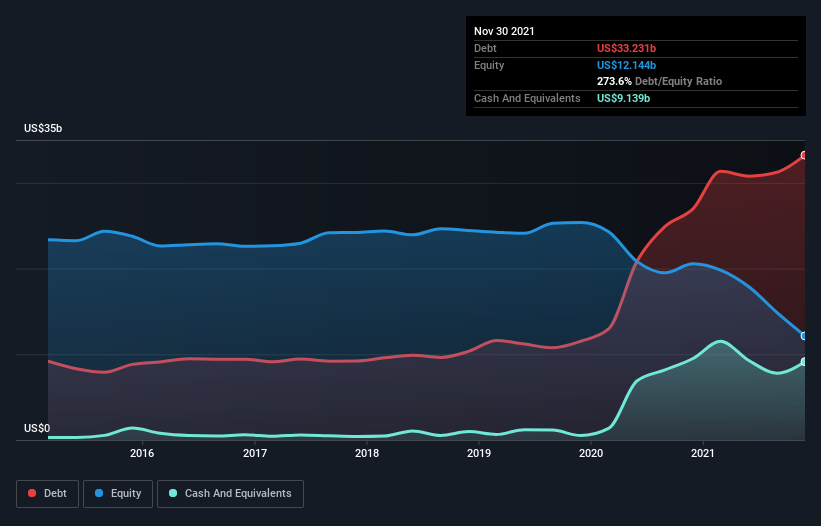- United States
- /
- Hospitality
- /
- NYSE:CCL
Health Check: How Prudently Does Carnival Corporation & (NYSE:CCL) Use Debt?
Warren Buffett famously said, 'Volatility is far from synonymous with risk.' So it seems the smart money knows that debt - which is usually involved in bankruptcies - is a very important factor, when you assess how risky a company is. We note that Carnival Corporation & plc (NYSE:CCL) does have debt on its balance sheet. But the more important question is: how much risk is that debt creating?
When Is Debt Dangerous?
Generally speaking, debt only becomes a real problem when a company can't easily pay it off, either by raising capital or with its own cash flow. Part and parcel of capitalism is the process of 'creative destruction' where failed businesses are mercilessly liquidated by their bankers. However, a more frequent (but still costly) occurrence is where a company must issue shares at bargain-basement prices, permanently diluting shareholders, just to shore up its balance sheet. Of course, plenty of companies use debt to fund growth, without any negative consequences. When we examine debt levels, we first consider both cash and debt levels, together.
See our latest analysis for Carnival Corporation &
What Is Carnival Corporation &'s Net Debt?
The image below, which you can click on for greater detail, shows that at November 2021 Carnival Corporation & had debt of US$33.2b, up from US$27.0b in one year. However, because it has a cash reserve of US$9.14b, its net debt is less, at about US$24.1b.

How Strong Is Carnival Corporation &'s Balance Sheet?
According to the last reported balance sheet, Carnival Corporation & had liabilities of US$10.4b due within 12 months, and liabilities of US$30.8b due beyond 12 months. On the other hand, it had cash of US$9.14b and US$246.0m worth of receivables due within a year. So its liabilities outweigh the sum of its cash and (near-term) receivables by US$31.8b.
Given this deficit is actually higher than the company's massive market capitalization of US$24.9b, we think shareholders really should watch Carnival Corporation &'s debt levels, like a parent watching their child ride a bike for the first time. Hypothetically, extremely heavy dilution would be required if the company were forced to pay down its liabilities by raising capital at the current share price. The balance sheet is clearly the area to focus on when you are analysing debt. But it is future earnings, more than anything, that will determine Carnival Corporation &'s ability to maintain a healthy balance sheet going forward. So if you're focused on the future you can check out this free report showing analyst profit forecasts.
In the last year Carnival Corporation & had a loss before interest and tax, and actually shrunk its revenue by 66%, to US$1.9b. That makes us nervous, to say the least.
Caveat Emptor
Not only did Carnival Corporation &'s revenue slip over the last twelve months, but it also produced negative earnings before interest and tax (EBIT). Indeed, it lost a very considerable US$6.3b at the EBIT level. When we look at that alongside the significant liabilities, we're not particularly confident about the company. It would need to improve its operations quickly for us to be interested in it. Not least because it burned through US$7.7b in negative free cash flow over the last year. So suffice it to say we consider the stock to be risky. There's no doubt that we learn most about debt from the balance sheet. But ultimately, every company can contain risks that exist outside of the balance sheet. For example - Carnival Corporation & has 3 warning signs we think you should be aware of.
Of course, if you're the type of investor who prefers buying stocks without the burden of debt, then don't hesitate to discover our exclusive list of net cash growth stocks, today.
New: AI Stock Screener & Alerts
Our new AI Stock Screener scans the market every day to uncover opportunities.
• Dividend Powerhouses (3%+ Yield)
• Undervalued Small Caps with Insider Buying
• High growth Tech and AI Companies
Or build your own from over 50 metrics.
Have feedback on this article? Concerned about the content? Get in touch with us directly. Alternatively, email editorial-team (at) simplywallst.com.
This article by Simply Wall St is general in nature. We provide commentary based on historical data and analyst forecasts only using an unbiased methodology and our articles are not intended to be financial advice. It does not constitute a recommendation to buy or sell any stock, and does not take account of your objectives, or your financial situation. We aim to bring you long-term focused analysis driven by fundamental data. Note that our analysis may not factor in the latest price-sensitive company announcements or qualitative material. Simply Wall St has no position in any stocks mentioned.
About NYSE:CCL
Carnival Corporation &
A cruise company, provides leisure travel services in North America, Australia, Europe, and internationally.
Solid track record and good value.
Similar Companies
Market Insights
Community Narratives





